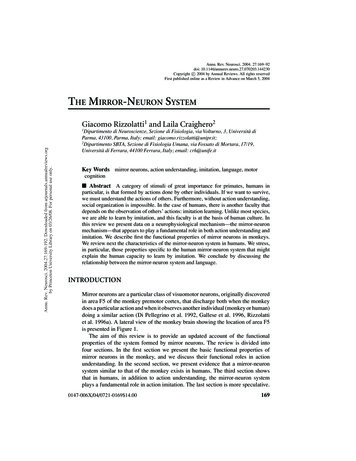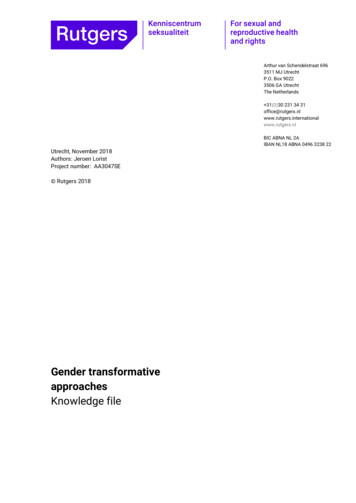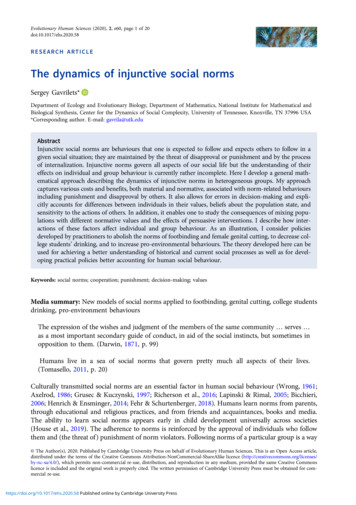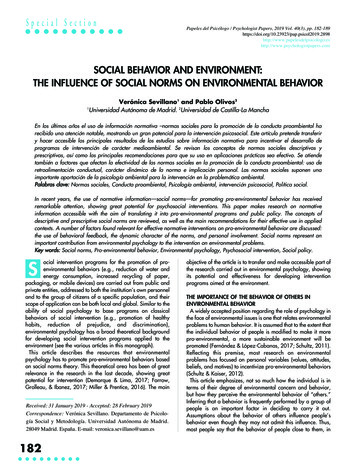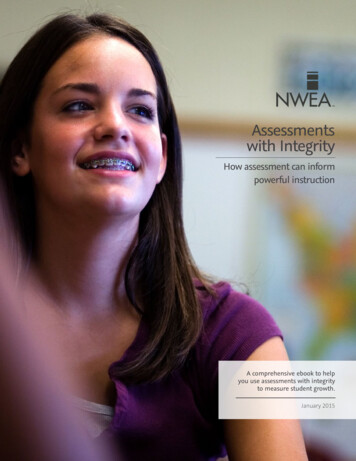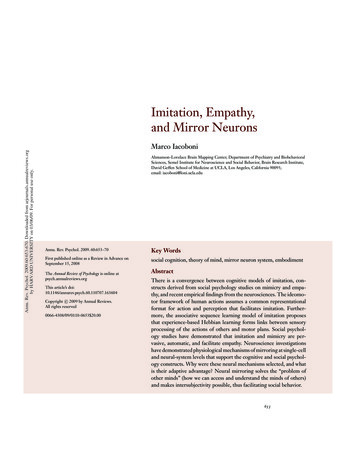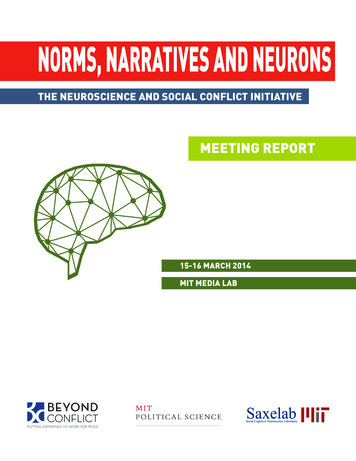
Transcription
A PROGRAM OF THE NEUROSCIENCE AND SOCIAL CONFLICT INITIATIVEMARCH 15-16, 2014MIT MEDIA LABNORMS, NARRATIVES ANDLee-Or Ankori KarlinskyBeyond ConflictBen ArmstrongMassachusetts Institute of TechnologyChristina AsquithBeyond ConflictA PROGRAM OF THE NEUROSCIENCE AND SOCIAL CONFChris BedfordRose Art Museum, Brandeis UniversityEileen BabbittFletcher School for Diplomacy, Tufts UniversityAdam BerinskyMassachusetts Institute of TechnologyMelinda BurrellDemocracy and Peacebuilding ConsultantRobert CialdiniArizona State UniversityNir EisikovitsSuffolk UniversityAlin ComanPrinceton UniversitySalma El BeblawiSoliyaAllison HarperFormer President ACLU-MarylandIna BreuerBeyond ConflictTurhan CanliStony Brook UniversityEmily FalkThe University of PennsylvaniaAdele LuteDefense Advanced Research Project AgencyMelissa NoblesMassachusetts Institute of TechnologyBruce HitchnerTufts UniversityCaroline JonesMassachusetts Institute of TechnologyLaura LigouriMassachusetts Institute of TechnologyLee-Or Ankori KarlinskyBeyond Conflict John PackerRose McDermottBrown UniversityBen ArmstrongMassachusetts Institute of TechnologHuman Rights and Education Center, University of OttawaEileen Babbitt Roger PetersenTim Phillips ChrisColonel David PendallInstituteTuftsof TechnologyBeyond ConflictU.S. Army Intelligence Liaison to MIT FletcherLincoln LaboratoryRoseSchool Massachusettsfor Diplomacy,UniversityTed PicconeBrookings InstitutionAmanda RothschildMassachusetts Institute of TechnologyPhilip RubinWhite House Office of Science and TechnologyAdam BerinskyMassachusetts Instituteof TechnologyAdam StromKathyrn SikkinkJohn F. Kennedy School of Government, Harvard UniversityAbigail DusseldorpBeyond ConflictTakao HenschConte Center, Harvard UniversityMargareta “Magda” MatacheFXB Center for Health and Human Rights, Harvard UniversityHugh O’DohertyJohn F. Kennedy School of Government, Harvard UniversityMARCH 15MIT MEDFotini ChristiaMassachusetts Institute of TechnologyJustine HardyMental Trauma Specialist and founder of Healing KashmirKelly GreenhillTufts UniversityMarika Landau-WellsMassachusetts Institute of TechnologyEmile BruneauMassachusetts Institute of TechnologyGeorgeta DragiouMDC StrategiesJennifer DixonVillanova UniversityAmy HeinDefense Advanced Research Project AgencyDonna HicksWeatherhead Center for International Affairs, Harvard UniversityAlexander KellMassachusetts Institute of TechnologyKim BrizzolaraCreative Visions FoundationWilliam CasebeerDefense Advanced Research Project AgencyJustin de Benedictis-KessnerMassachusetts Institute of TechnologyCharles ‘Chip’ HaussAlliance for PeacebuildingMichal Ben-Josef HirschBelfer Center, Harvard UniversityFacing History Facing OurselvesIna BreuerBeyondConflictVeton SurroiBedfordArt Museum, Brandeis UnivCarlos SaladrigasCuba Study GroupKim BrizzolaraCreative Visions FounThe Kosovo Foreign Policy ClubStephen vanEveraTurhan CanliWilliamCasebeerDave TaffelCody ValdesMelindaBurrellMassachusettsInstitute ofTechnology Research ProjectPhilosopherandand WriterInstitute for Global Leadership,Tufts UniversityStony ng ConsultantJohanna Ray VollhardtUniversityRobertClarkCialdiniArizona State UniversityJim WalshDean WilliamsMassachusetts Institute of TechnologyF. Kennedy School of Government, Harvard UniversityAlin ComanJustin deJohnBenedictis-KessnerJennifer DixonPrinceton UniversityMassachusetts Institute of TechnologyVillanova UniversityStephen WittlesMassachusetts Institute of TechnologyNir EisikovitsSuffolk UniversityJonathan WolffTufts UniversitySalma El BeblawiSoliyaAllison HarperFormer President ACLU-MarylandKetian ZhangMassachusetts Institute of TechnologyEmily FalkThe University of PennsylvaniaCharles ‘Chip’ HaussAlliance for PeacebuildingKelly GreenhillTufts UniversityJustineMentalAmy HeinDefense Advanced Research Project AgDonna HicksWeatherhead Center for International Affairs, Harvard UniversityBruce HitchnerTufts UniversityCarolinMassac
The Neuroscience and Social Conflict Initiative is a major multi-year effort that seeks to utilizeadvances in neuroscience to better understand universal human reactions to conflict, cultivate aNeuroscience and Social Conflict field, and disseminate the initiative’s insights to key policy andresearch audiences.2
On March 15-16, 2014, Beyond Conflict (formerly the Projecton Justice in Times of Transition), in partnership with MIT’sSaxeLab for Social Cognitive Neuroscience and MIT’s PoliticalScience Department, organized a two-day event entitledas part of itsNarratives and norms are inherent to the way we perceive,interpret, and act within our social environment. Groupscreate unconscious borders of acceptable behavior, enforcethem through a variety of organic and formal means, and.sustain and justify them using collective stories, or narratives.Beyond our own personal preferences, aspirations, or moralsensibilities – these norms and narratives shape our socialand personal worlds, and frame what we consider acceptable,and sometimes imaginable, behavior. These are essential. The objective is ultimately to transformand improve the way domestic and international conflict isunderstood and mitigated.Themeeting was thesecond mapping meeting designed to survey what is knownabout core areas of human affect and behavior that are widelyassumed to be at play before, during, and after conflict. The firstmapping meeting was on, andfuture meetings are planned on topics such as memory andtrauma, and sacred values.tools for the survival of individuals and groups, and they areever more important in an environment of intractable conflict,pervasive fear, and frequent violence.In a conflict situation, norms and narratives often serve ascrucial adaptations that help groups and individuals copewith threats to their survival. They help us make sense of thetraumatic events around us and implicitly guide us towardssafety from harm and exclusion. In the process, they alsobecome central pillars of who we are and how we see oursurroundings and ourselves.And yet, precisely because they remain so central to groupbehavior and identity, these norms and narratives oftenhamper the efforts of activists, negotiators, diplomats, and.It is with these larger objectives in mind that the Neuroscienceand Social Conflict Initiative undertook an exploration ofrecent findings in cognitive neuroscience, the social sciences,and from direct experiences in the field on the ways normsand narratives can motivate behavior change in conflictsettings. The key question driving the meeting was:And during the course of the meetingpractitioners to prevent and resolve conflict and to promotereconciliation. Too often, leaders struggling to reach peace orreconciliation seem to get stonewalled by deeply entrenchednarratives of conflict. Too often, practitioners working toprevent violence fail when groups and individuals revert to oldnorms of violence as dispute resolution. Too often, activistssee narratives and norms of sectarianism become more andmore entrenched without any recourse to prevent them fromleading to violence and division.the overriding concern of the participants was further refinedto the question:3
. Not many researchers havestudied norms or narratives in the context of conflict and notmany neuroscientists have looked into the neural correlates ofnorms and narratives. Still, the fields of sociology, psychology,and neuroscience are in a position to offer some importantinsight into the mechanisms of narratives and social norms., Co-founder and Chair of Beyond Conflict andmeeting moderator, opened the meeting by asking, “What iscommon in humans that drives them towards conflict? Canneuroscience tell us how to use norms and narratives tochange this behavior?” And he spoke to the objective of theTo facilitate this research, Beyond Conflict hosted this eventmeeting and the overall initiative in terms of getting a handlewith the overall goal of understanding how social norms andon “the emerging scientific basis for answering ‘What drivesnarratives arise, become effective, and change, both in generalhuman behavior?’”and, specifically, in conflict contexts. The hope was to catalyzea cross-disciplinary conversation about the role normsand narratives play in social conflict – How are narrativessurrounding conflict formed and distributed? What behavior isconsidered socially acceptable and even encouraged within agroup and towards other groups? How do narratives influencenorms and vice versa? How do norms and narratives changeand how can they be changed? – a conversation that will leadto cutting-edge interdisciplinary research and eventually,better approaches, tools, and methods for diplomats, leaders,and practitioners., Research Scientist at the MIT SaxeLab,contextualized the opening discussion with a brief sketchof the conceptual framework of the conference. In thesocial sciences and cognitive neuroscience, he said, thereis a common analogy of how the brain works. The rider representsthe part of the brain to which one has introspective access,the part with which you can directly communicate. But theanalogy emphasizes that a vast majority of the brain – theelephant – is completely opaque to introspection. We do notknow what processing is going on there. And this is one of thegreat realizations of social psychology: that there are a lot ofprocesses going on behind the scenes that are driving humanbehavior. This is whatneuroscience is attempting to measure directly and hopefullythat is the contribution it can make; allowing us to knowabout the processes and functions, not just of the part of thebrain to which we have direct introspective access, but of theentire brain.4
The brain is described as like a rider on an elephant. The rider represents the part of the brainto which one has introspective access, the part with which you can directly communicate.But the analogy emphasizes that a vast majority of the brain – the elephant – is completelyopaque to introspection.5
that influence human behavior. There areThe first set of presenters, though not all neuroscientists,focused a great deal on what neuroscience is telling us abouthow norms, in particular, are being found to have a dramaticeffect on human behavior. The ability to change norms and shiftthe narratives in which they are embedded in predictable wayswas demonstrated to a surprising degree, as was the extent towhich such changes can affect human behavior on individual,small group, and societal levels. Finally, the importance ofthe messenger who delivers the norm or narrative changingmessage was addressed, and it was shown that this factor isarguably just as important to shifting norms, narratives, andbehavior as is the message being delivered., Professor of Psychology at Arizona StateUniversity, argued that behavior can be effectively changedthrough influencing psychological tendencies. He focused onthe power of norms to influence behavior and, in particular,environmentally related behavior. Very often programdevelopers try to leverage change by using financial or;norms of what people commonly do, what is normal in thesituation. Descriptive norms motivate us to behave in certainways by subtly informing us of what is likely to be effective andfunctional in that situation. If a lot of people like us are doingsomething, then we say, “Oh that’s something I can do as well.”There is another kind of norm that sociology talks about interms of shared expectations; it’s about approved conduct inthe culture. Those are called. They enjoinpeople to behave in a certain way. Whereas descriptive normsinform us into agreement, injunctive norms sanction us intoassent in terms of informal sanctions such as approval anddisapproval.The power of descriptive norms, according to Cialdini, isunderemployed and under-recognized. It is much more like theelephant than the rider. It is the one that occurs automaticallyand spontaneously. With very little cognitive effort we canbe moved in a particular direction by the simple recognitionof what those around us and like us are doing or have beendoing. An example of this is a study done in Beijing whereThe norm says people are likely to follow the lead of many comparable others. That means it willnot just be “many others” that will stimulate behavior change, it will be “similar others”.regulatory motivators of that change. But those are costlyon the financial side and regulation has a social cost. Peopledon’t like being regulated into action and they often resistsuch efforts. There is another set of motivators of change,he argued, those with a psychological foundation, those thatare aligned with fundamental human tendencies. If we canarrange our messaging so that people are likely to behave inways that are consistent with their fundamental inclinationsand move in our direction, little is lost in the bargain.Normative theory suggests that there are two kinds of norms6restaurant owners could predictably influence the likelihoodthat customers would choose a specific item on the menu bysimply marking those that were most popular as such. “Theseare our most popular items.” The consequence was eachone became 20 to 30 percent more popular, without changinganything about the items themselves. No coercion and noinvestment is required. It is entirely ethical and entirely honest,he stressed. This strategy goes unregistered, unrecognized,and generally unemployed.
The subtextmessage is: “This is what all your neighbors are doing.” It is. It is “many comparable others”more primitive and more powerful than rational calculationswho most reduce my uncertainty about what I should do inabout being caught. Instead we should use the injunctive normthe same situation. Some evidence of this comes from onehere. Giving people evidence of what the majority approvesof Cialdini’s studies with hotels in the Phoenix area. In manyand disapproves of can cancel the negative consequences ofhotels now there are cards asking you to reuse your towelsan undesirable social norm. “Many people are doing this butand linen. There is usually some sort of endangered woodlandmost of us don’t approve of it – that will reverse the negativecreature on them.effect.”Since it is not just what many others do, it is what similarCialdini argued this is where there is an intersection ofothers do, he tried a sign that told people that the majority ofnorms and narratives:guests who have stayed in “this room” (and it had the roomnumber on it) have reused their towels at least once. Under. This can be very successful, hethose circumstances hotels got more compliance than eversaid, citing the work of, Professor ofbefore.Psychology at Princeton University, (and a presenter at theIt reveals an automatic,inaugural Neuroscience and Social Conflict Initiative meeting).non-rational response to the perception of what those aroundPaluck has done research in sub-Saharan Africa with radious and like us are doing. It does not require a lot of cognitivesoap operas in which the players are acting in conciliatory,capacity. “Birds fly together, cattle herd together; you don’tpeaceable ways rather than in violent, aggressive ways inneed a lot of cortex for this. It’s below that.”intergroup interactions and also with domestic violence. “ThisIs there any way to tell whether this is generalizable topeople’s decisions in their everyday behavior? Cialdini did astudy trying to get homeowners to reduce their energy usage.What is the best message to send to do this?is who we are” is implicitly communicated by the storyline.This strategy significantly reduced hostile attitudes towarddifferent groups and behaviors towards those groups andin terms of domestic violence. “This is how we can link thenorms and the narratives to carry that message and win theInformationand admonitions are not enough to move people to changetheir behavior. You have to give them a reason to change.day,” maintained Cialdini. Informing individuals through theuse of a story-based narrative can be successful in eithermotivating or preventing certain behaviors, depending onwhich norms are invoked.But what do we do when the majority is not acting in a sociallydesirable way? You can’t use the descriptive norm and say,More often, as we“Look at what all your neighbors are doing.” That’s when it isshall see below, practitioners unwittingly use narratives tonecessary to resort to the injunctive norm.shift norms. The prospect of bringing this process to the levelof purposeful, conscious programming was highly motivatingto many of the participants.began by focusing on changing hearts,and emphasized the role of empathy in affecting peoples’7
Dr. Emile Bruneau,Research Scientist at the MIT SaxeLab8
responses to emotional narratives. People generally think ofhe said. We tell people they arechanging hearts in terms of increasing empathy for the othercompeting and then show them a bunch of stories about in-group, like increasing Americans’ empathy for Arabs and vicegroup and out-group members, and they report how good orversa. But Bruneau explained thatbad they feel about things that happen to members of their ingroup versus out-group members. And indeed this reveals, viaself-report, that they feel a lot more badly for members of theirin-group when some misfortune is described as happening to. Thisis because political violence arises when individuals havethem than they do for similarly affected members of the outgroup.high levels of empathy for their in-group and little empathytowards out-groups. This presents an interesting paradox. Itis borne out by a lot of empirical evidence that shows that. So competition iskey, but it doesn’t even need to be explicit. We can just givethem an impression that the groups are different and we still: peoplelike the female Palestinian paramedic who carried out thefirst suicide bombing in the first intifada. If you have a lot ofin-group empathy, then you are likely to be motivated to acton behalf of your in-group. And if you have little out-groupsee this dramatic gap. “Parochial empathy matters.”Bruneau asked, “Can narratives alter parochial empathy?” If youportray the other side, will it actually decrease the parochialismwe feel?empathy, then the barrier to harming them is lowered.Bruneau’s research has found that this. Incontrast, if individuals are introduced to narratives that endowthe out-group with physical characteristics but do not endowthe out-group with mental characteristics – do not focus on theother’s thoughts – parochial identity is not only not reduced, itmay even be increased. And as an example he cited supporting evidencefrom his work trying to get Americans to take small actionsto aid Palestinians or Arabs. He also cited work ofof the New School for Social Research (also a presenterat the first Neuroscience And Social Conflict Initiative meeting)that has shown that“Sometimes one needs to take an oblique approach toconflict resolution” he commented. “Yes, we often want to getopponents to do ‘perspective taking,’ to take the perspectiveof the other, hoping they will find that the other is not so other,not so different as they thought. But this can also producea paradoxical effect, because you can think of the other’snegative thoughts about you, which hardens your barrier to the.Moreover, Bruneau has found in systematic, scientific studiesin which participants are arbitrarily assigned to purelyartificial groups (e.g., red group versus blue group), the levelof parochial empathy is very high.other.”.Bruneau then shifted to address “how we take this to thescanner” to overcome the shortcomings of self-report bydescribing his work on neuroimaging through fMRI scansthat seek to examine how different parts of the brain respond9
to ideological narratives. His research had people lie in ascanner and read different stories that would evoke emotional. The emotional system in the brain primes us toresponses and ones that would not. This enabled him to seeaction based on reward and threat mechanisms. The samewith neuroimaging that in-group empathy-evoking narrativesunderlying brain mechanisms are tying together diverseare associated with different parts of the brain than out-groupphenomena. “Opinions of others affect us,” she said, “whyempathy-evoking narratives.and how?” This is the challenge of understanding throughFinally Bruneau discussed his studies putting Arabs andIsraeli’s into the scanner and exposing them to pro- and anti-neuroscience how to predict behavior, both on an individuallevel and on a larger social scale.Arab and pro- and anti-Israeli narratives. These ideologicalnarratives were found to affect the precuneus region of thebrain which is activated by social cognition, thinking about otherpeople’s thoughts, and also by self-referential information,“how does this affect me?” and it revealed that Israelis’ brainsresponded to pro-Arab narratives similarly to the way theyresponded to irrational narratives, whereas Arabs respondedthat way to the pro-Israeli narratives. Bruneau has foundpreliminary evidence that these results can be reproducedusing members of Republican and Democratic parties.Bruneau concluded by asserting that researchers canintervene in how the brain responds to in-group and outgroup narratives by understanding which parts of the brainFalk’s research further looks at how norms, values, andbehaviors spread from person to person, what makes oneindividual more successful than another in communicatinga behavior changing norm to members of their wider socialenvironment, how broader level, social structures interactwith what is going on in our brain, and what this can that tellus about what is happening on larger social scales.First, she talked about neural processes that are involvedin receptivity to influence and discussed what determineswhether influence takes hold, what determines behaviorchange. She focused on the brain’sare involved in processing different narratives, and futureresearch has the potential to foster open-mindedness by. Falk found. Such research could havesignificant implications for understanding and intervening inconflictsthat differences in responsiveness in this part of the brain seemto be indexing a certain kind of self related processing, animplicit value-to-the-self processing. When we look at neuralactivity in this part of the brain, in response to messages that, Assistant Professor of Communication at theare designed to change behavior, messages that in her studiesUniversity of Pennsylvania, presented work that Bruneau hadwere designed to get people to quit smoking, we find that thepreviously said was rare in neuroscience at present insofaras it shows how neuroscience can already move from thetheoretical to the practical realm and be used to influencebehavior right now. Falk started with the provocative idea that“neural findings can tie all this (i.e., what has been discussedso far) together.”10.In addition, preliminary evidence suggested that neuralresponses as observed in relatively small groups, such as 30people, parallel what occurs on a larger social scale and can
Cross-section of brain with pre-frontal cortex highlighted in red.11
Dr. Emily Falk,Assistant Professor of Communication,The University of Pennsylvania12
therefore accurately forecast which messaging campaignswill elicit widespread change. They serve as kind of. Moreover, measurement of such activity wasa much better predictor of the likelihood of behavior change. It is completely logical. Peoplethan self-reports. The least liked campaign according to self-are defensive against self-relevant messages that say “whatreport was found through neuroimaging to produce the mostyou are doing is bad for you and you are going to die.” Theyactivity in the medial prefrontal cortex. And in her studieshave strong motivation to argue against them. So Falkon anti-smoking campaigns in which she looked at calls toexamined whether affirmation priming could increase activityquit-smoking hotlines before and after the airing of differentin the brain’s valuation system of such individuals and therebycampaign messages,influence the likelihood of getting them to change behavior. Falkdiscovered through questionnaires which values (unrelatedto health) individuals ranked higher than others. Invoking.Falk then developed a study in which she had more control overthe messaging, which concerned an anti-smoking campaignconducted by email. She used 20 different threatening anti-these before presenting individuals with health relatedmessages, she found preliminary evidence that reflectingon personally salient values made them more receptive toself-relevant threatening messages. This indicated thatsmoking messages and 20 relatively neutral messages thatwere each sent to a different group of 800,000 recipients. Shealso collected fMRI data concerning increased neural activityin the medial prefrontal cortex from a group of 50 smokersexposed to these messages. What she found was that therewas a positive correlation between increased neural activity. So the answer to her question about thepossibility of pushing around brain activity in order to changebehavior was yes:in the medial prefrontal cortex of the small group and helpseeking activity of the large scale, email receiving groupsthat got anti-smoking ads that were personally relevant andcontained a threatening health risk message. This positiverelationship was not present in the neutral control ads usedin the study, suggesting that the medial prefrontal cortex wasindexing the ability of risk messages to elicit a certain kindof productive and self-related processing as well as behaviorchange.She tested thisin the lab with brain scans of sedentary adults and found thatthe effects of values affirmation is reflected in increased brainactivity which predicts increased physical activity over thecourse of the following month. The wider implications of thisare that we can produce more medial prefrontal cortex activity,and this predicts receptivity to behavior-change messagingand consequent behavior change itself. In Falk’s words,“Neuroscience can really give us some suggestions about“Is it possible to push around this neural activity?” Falk asked.places we might want to ‘poke’ in an effort to move behaviors“Can we increase medial prefrontal activity in response todown the road.”threatening information, and does that in turn predict behaviorchange?” To answer these questions, Falk conducted a studyfocused on changing the physical behavior of sedentaryadults. She leveragedWe also know that interpersonal influence matters. So Falknext turned her attention to the factors that make informationand value sharing among individuals in networks effectivein spreading messages and influencing behavior.13
whether those who have more activity in these brain regionsto begin with are drawn to develop larger and more diversesocial networks, and found preliminary data that the formeris indeed the case. The more opportunities individuals have. So what makes people want to exchange ideas,what makes them want to pass on information to others?to communicate with diverse others, the greater the activityin their mentalizing-systems.And what makes some people more successful than othersin passing on information? How do we get people onboardwith spreading those norms further? And finally, how does.this relate to broader social environments? The new mediaenvironment gives us an incredible capacity to quantify socialnetworks that we never had before.Her lab has started to ask whether they can push aroundsocial cognition, i.e., push around mentalizing networkShe described studies that involved not only the self-relatedactivity, using language. Falk presented preliminary evidenceprocessing areas of the brain but also the “perspectivedemonstrating that when ideas are described with moretaking” or “mentalizing” parts of the brain – the temporo-social language, researchers can increase neural activity inparietal junction and dorsal medial prefrontal cortex. Theythe temporo-parietal junction and thereby influence behaviorshowed that self-related processing activity was related to thechange, which in this context meant that individuals who hadintention to spread messaging and share information, just asthe most activity when viewing the messages used moreit was an indicator of receptivity to messaging and behaviorsocial language when propagating the ideas to others whenchange. But what is associated with being effective in sharingthey were outside of the scanner. This allows us to tie togetherinformation? Through her study Falk found that the ability tothe different pieces of the behavior change puzzle on theseget people onboard with your preferred ideas – to recreatedifferent levels. We can look at brain activity in these differentyour valued ideas in the minds of others – is “a different ball ofregions to understand what is going on mechanistically andwax.” It was found in her studies to involve heightened activitywhich messages and individuals are going to be the mostin the temporo-parietal junction and dorsal medial prefrontalsuccessful in propagating behavior change, and on the largecortex – the “perspective taking” or “mentalizing” parts ofscale level we can look at language data from new socialthe brain.media, and when we try to figure out the process, movingfrom individual behavior change to large-scale social behaviorchange, we can triangulate between them both. We can collectFalk went on to hypothesize that the tendency to recruit thethe same kinds of data in both situations and with computerperspective taking brain system “almost certainly” variesscience we can automate the analysis of these kinds of rawas a function of social context. And in her studies,data.Taken together, Falk suggested, these results give someexamples of ways that integrating the expertise present at thismeeting, from neuroscience all the way up through population. Sh
A PROGRAM OF THE NEUROSCIENCE AND SOCIAL CONFLICT INITIATIVE MARCH 15-16, 2014 . Princeton University Georgeta Dragiou MDC Strategies Justin de Benedictis-Kessner . Soliya Emily Falk The University of Pennsylvania Kelly Greenhill Tufts University Justine Hardy Mental Trauma Specialist and founder of Healing Kashmir Allison Harper Former .


